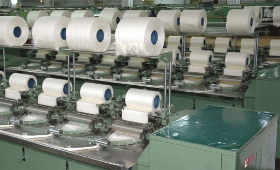|
|
|

|
Textile sector needs more support to arrest shrinking market share
|
|

|
|
| Top Stories |
 |
|
|
|
SME Times News Bureau | 21 Jul, 2021
India's share in global exports of cotton yarn shrunk 600 basis points
to 23 per cent in calendar year 2020 (CY2020) from 29 per cent in
CY2015, while in readymade garments (RMG), its share has stagnated at
3-4 per cent over the past decade.
Lack of free trade agreements (FTAs) and significant improvement in peer competitiveness are the main reasons for this fall.
Textiles
is important to India's $313 billion merchandise exports as it accounts
for 11 per cent of the pie. The sector is also a significant employment
generator.
Given its economic importance, the sector has seen a
slew of measures from the government of late, including the textile
parks announced in Union Budget 2021-22 and inclusion of the sector for
allocations under the Production- linked Incentive (PLI) scheme.
While
these are steps in the right direction, a CRISIL Research's analysis
indicates more is needed to address the issues and spur a revival.
In
cotton yarn, India has lost market share over the past decade to
Vietnam and China because of high cost and lack of FTAs amid
intensifying competition.
In RMG, India has done well to maintain
its share even as global trade in the segment contracted. But
competitors such as Vietnam and Bangladesh have done much better - they
capitalised on China's falling share in the past five fiscals, while
India could not.
Further, Indian textiles players were pushed to
the brink in 2020 as the Government of India reduced export incentives
in line with guidelines of the World Trade Organization.
CRISIL
Research does not expect any significant improvement in incentives with
the launch of the Remission of Duties and Taxes on Export Products
(RoDTEP) scheme, which aims to reduce tax burden of exporting entities.
However, to revive the textile value chain, the government has
announced additional structural reforms whose impact needs to be
evaluated.
The recently announced PLI scheme for man-made fibres
(MMF) and technical textiles is expected to improve the potential of
MMF-based RMG exports where India's share has been weak. Along with the
integrated textile parks scheme, the PLI scheme may help the sector
enhance its export share over the medium to long term, if implemented
well. However, continuous support in terms of trade negotiations, more
investments to improve infrastructure at larger scale may be needed.
India
is in a favourable position with China facing political backlash
globally, but capitalising on this opportunity would need continuous and
concerted effort.
|
|
|
| |
|
|
|
|
|
|
|
|
|
|
|
|
|
|
| |
| Customs Exchange Rates |
| Currency |
Import |
Export |
US Dollar
|
₹91.25
|
₹89.55 |
UK Pound
|
₹122.85
|
₹118.85 |
Euro
|
₹107.95
|
₹104.3 |
| Japanese
Yen |
₹59 |
₹57.1 |
| As on 29 Dec, 2025 |
|
|
| Daily Poll |
 |
 |
| What is your biggest hurdle to scaling right now? |
|
|
|
|
|
| Commented Stories |
 |
|
|
|
|
|
| |
|